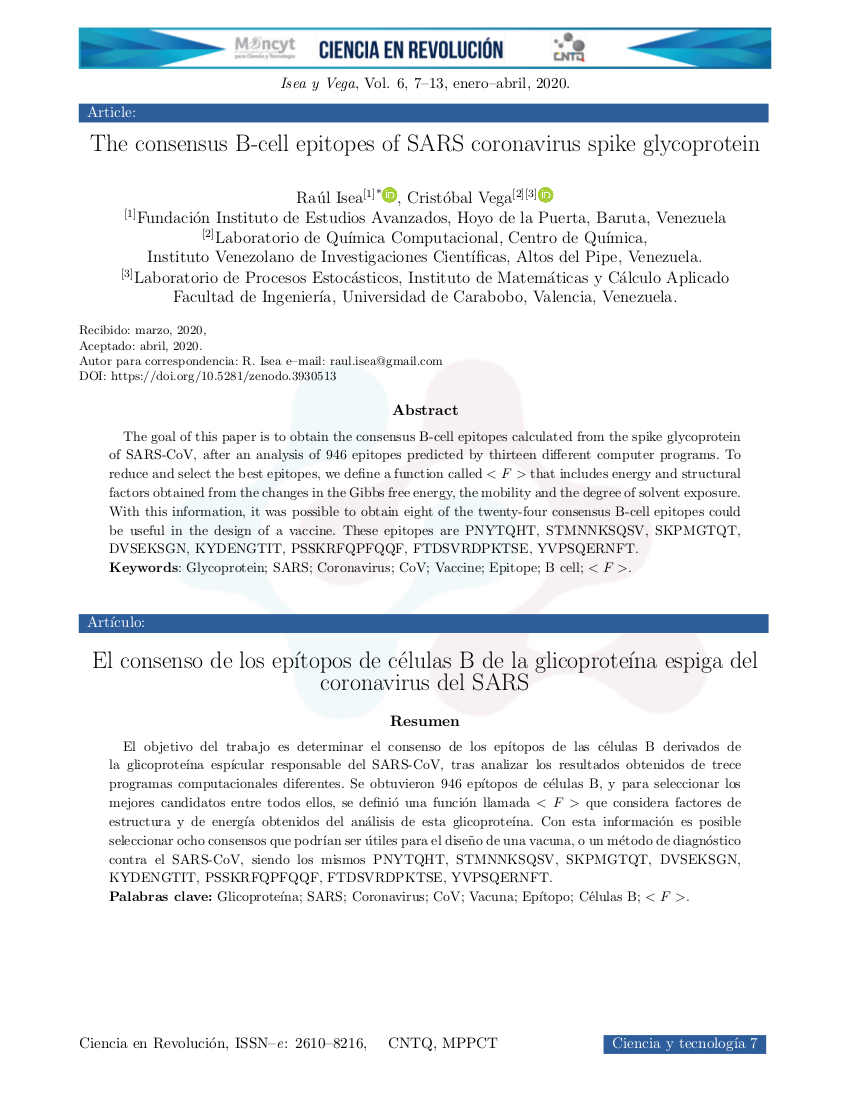Recibido: /marzo, 2020. Aceptado: /abril, 2020. Recibido: /marzo, 2020. Aceptado: /abril, 2020.
Contenido principal del artículo
Resumen
El objetivo del trabajo es determinar el consenso de los epítopos de las células B derivados de la glicoproteína espícular responsable del SARS-CoV, tras analizar los resultados obtenidos de trece programas computacionales diferentes. Se obtuvieron 946 epítopos de células B, y para seleccionar los mejores candidatos entre todos ellos, se definió una función llamada < F > que considera factores de estructura y de energía obtenidos del análisis de esta glicoproteína. Con esta información es posible seleccionar ocho consensos que podrían ser útiles para el diseño de una vacuna, o un método de diagnóstico contra el SARS-CoV, siendo los mismos PNYTQHT, STMNNKSQSV, SKPMGTQT, DVSEKSGN, KYDENGTIT, PSSKRFQPFQQF, FTDSVRDPKTSE, YVPSQERNFT.
Descargas
Detalles del artículo
Referencias
P.A. Rota, M.S. Oberste, S. S. Monroe, W. A. Nix, and E. Campganoli. Characterization of a Novel Coronavirus Associated with Severe Acute Respiratory Syndrome. Science, 300: 1394–1399, 2003.
F. Li. Structure, Function, and Evolution of Coronavirus Spike Proteins. Annual Review of Virology. 3(1): 237–261, 2016.
J.L. Nieto-Torres, M.L. DeDiego, C. Verdiá-Báguena, J.M. Jiménez-Guardeño, J.A. Regla-Nava, R. Fernández-Delgado, C. Castaño-Rodríguez, A. Alcaraz, J. Torres, V.M. Aguilella, y L. Enjuanes. Severe Acute Respiratory Syndrome Coronavirus Envelope Protein Ion Channel Activity Promotes Virus Fitness and Pathogenesis. PLoS Pathogens, 10(5): e1004077, 2014.
W. Song, M. Gui, X. Wang, and Y. Xiang. Cryo-EM. Structure of the SARS Coronavirus Spike Glycoprotein in Complex with its Host Cell Receptor ACE2. PLoS Pathogens. 14: 07236, 2018.
J. Sarkander, S. Hojyo,and K. Tokoyoda. Vaccination to Gain Humoral Immune Memory. Clinical & Translational Immunology. 5(12): e120, 2016.
R. Isea, R. Mayo-García, y S. Restrepo. Reverse Vaccinology in Plasmodium Falciparum 3D7. Journal of Immunological Techniques in Infectious Diseases. 5: 3, 2016.
A. Kazi, C. Chuah, A.B. Abdul M., C. Herng L., B. Huat-L., and C. Yee L. Current Progress of Immunoinformatics Approach Harnessed for Cellular- and Antibody-Dependent Vaccine Design, Pathogens and Global Health. 112(3): 123-131, 2018.
S. Ebrahimi, H. Mohabatkar, and M. Behbaha- Ni. Predicting Promiscuous T Cell Epitopes for Designing a Vaccine Against Streptococcus Pyogenes. Applied Biochemistry Biotechnoly 187: 90–100, 2019.
B. Manavalan, RG. Govindaraj, TH. Shin, MO. Kim and G. Lee, iBCE-EL: A New Ensemble Learning Framework for Improved Linear B-Cell Epitope Prediction. Frontiers Immunology. 9:1695, 2018.
M.C. Jespersen, B. Peters, M. Nielsen,and P. Marcatili. BepiPred-2.0: Improving Sequence-Based B-Cell Epitope Prediction Using Conformational Epitopes. Nucleic Acids Res. 45 (Web Server issue): W24–W29, 2017.
E.A. Emini, J.V. Hughes, D.S. Perlow, and J. Boger. Induction of Hepatitis A Virus-Neutralizing Antibody by a Virus-Specific Synthetic Peptide. Journal of Virology. 55(3):836-839, 1985.
A.S. Kolaskar, and P.C. Tongaonkar. A Semi-Empirical Method for Prediction of Antigenic Determinants on Protein Antigens. FEBS Letters. 276(1-2):172-174, 1990.
S. Saha, and G.P.S Raghava. Prediction of Continuous B-Cell Epitopes in an Antigen Using Recurrent Neural Network. Proteins. 65(1): 40- 48, 2006.
S. Saha, and G.P.S. Raghava. BcePred: Prediction of Continuous B-Cell Epitopes in Antigenic Sequences Using Physico-Chemical Properties.In G.Nicosia, V.Cutello, P.J. Bentley and J.Timis (Eds.) ICARIS, LNCS 3239, 197-204, Springer, 2004.
J.V. Ponomarenko, H. Bui, W. Li, N. Fusseder, P.E. Bourne, A. Sette A, and B. Peters. ElliPro: a New Structure-Based Tool for the Prediction of Antibody Epitopes. BMC Bioinformatics. 9:514, 2008.
P.H. Andersen, M. Nielsen, and O. Lund. Prediction of Residues in Discontinuous B Cell Epitopes Using Protein 3D Structures. Protein Science. 15: 2558-2567, 2006.
C. Zhou, Z. Chen, L. Zhang, D. Yan, T. Mao, K. Tang, T. Qiu,and Z. Cao. SEPPA 3.0—Enhanced Spatial Epitope Prediction Enabling Glycoprotein Antigens. Nucleic Acids Research. 47(W1): W388–W394, 2019.
M.J. Sweredoski, and P. Baldi. COBEpro: a Novel System for Predicting Continuous B-Cell Epitopes. Protein Engineering Design and Selection. 22(3): 113–120, 2009.
B. Yao, L. Zhang, S.Liang,and C.Zhang. SVMTriP: a Method Topredict Antigenic Epitopes Using Support Vector Machine to Integrate Tripeptie Similarity and Propensity. PloS One, 7(9):e45152, 2012.
S. Liang, D. Zheng, D.M. Standley, B. Yao, M. Zacharias, and C. Zhang. EPSVR and EPMeta: Prediction of Antigenic Epitopes Using Support Vector Regression and Multiple Server Results. BMC Bioinformatics, 11: 381, 2010.
R. Isea. Quantitative Prediction of Linear B-Cell Epitopes. Biomedical Statistics and Informatics. 2(1): 1-8, 2017.
R. Isea. Predicción de epítopos consensos de células B lineales en Plasmodium Falciparum 3D7. VacciMonitor, 22(1): 43-49, 2013.
R. Isea. Mapeo computacional de epítopos de células B presentes en el virus del Dengue. Revista del Instituto Nacional de Higiene “Rafael Rangel”. 44(1): 25-29, 2013.
R. Isea. Identificación de once candidatos vacunables potenciales contra la malaria por medio de la bioinformática. VacciMonitor. 19(3): 15-18, 2010.
R. Isea. Designing a Peptide-Dendrimer for Use as a Synthetic Vaccine Against Plasmodium Falciparum. American Journal of Bioinformatics and Computational Biology . 1(1): 1-8, 2013.
R. Isea. Predicción computacional cuantitativa de epítopos de células B. VacciMonitor. 24(5): 93-97, 2015.
G.D Rooman. PoPMuSiC, an Algorithm for Predicting Protein Mutant Stability Changes. Applications to Prion Proteins. Protein Engineering. 13(12):849-856, 2000.
V. Frappier,and R.J. Najmanovich. A Coarsegrained Elastic Network Atom Contact Model and its Use in the Simulation of Protein Dynamics and the Prediction of the Effect of Mutations. PLOS Computational Biology.10(4): e1003569, 2014.
R. Murphy, J. Casper, J. Hyams, M. Micire, and B. Minten. Mobility and Sensing Demands in USAR, 2000 26th Annual Conference of the IEEE Industrial Electronics Society. IECON 2000. 2000 IEEE International Conference on Industrial Electronics, Control and Instrumentation. 21st Century Technologies, Nagoya, Japan, pp. 138-142 vol.1, 2000.
A. Porollo, R. Adamczak, and J. Meller. POLY-VIEW: A Flexible Visualization Tool for Structural and Functional Annotations of Proteins. Bioinformatics, 20: 2460-2462, 2004.













